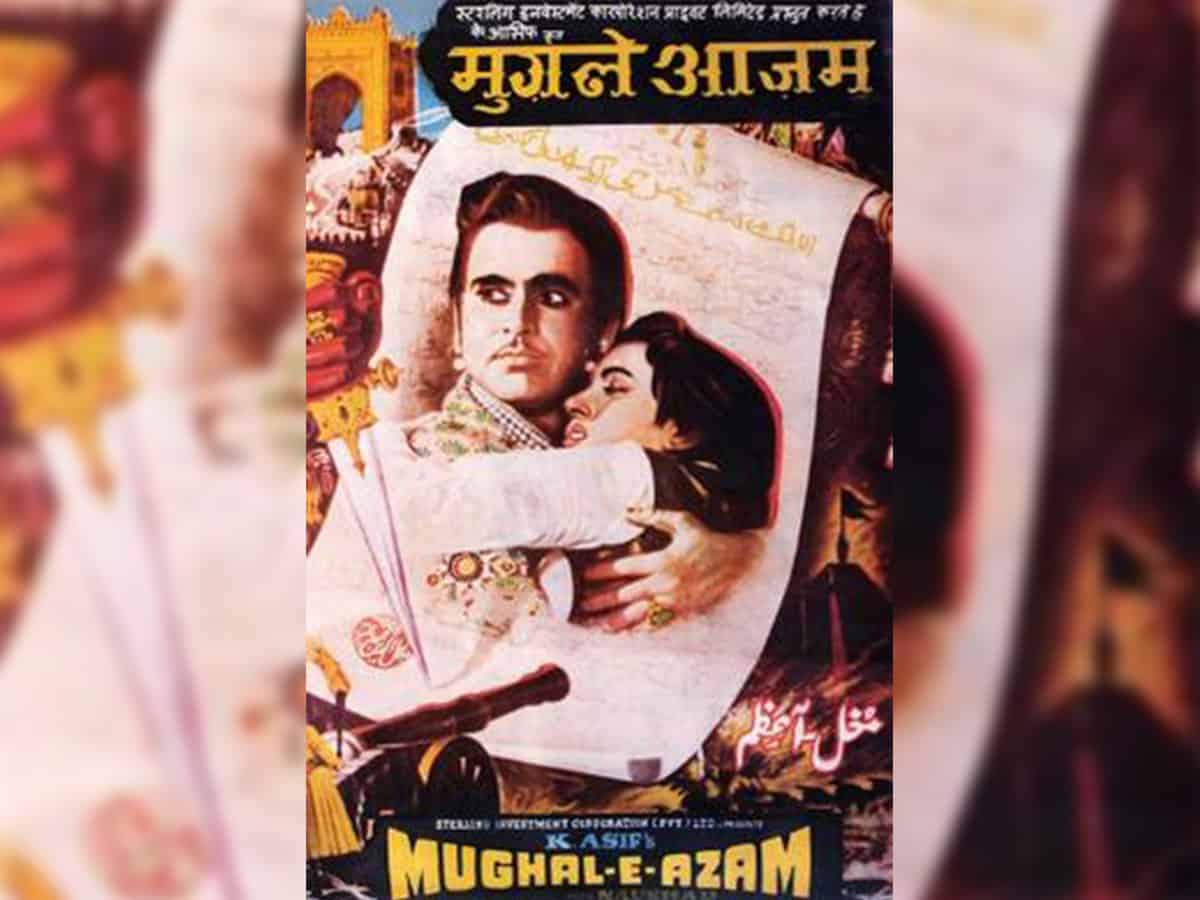
“Zah-e-naseeb! Kaanton ko murjhaane ka qauf nahi hota!” Anakali’s response to Prince Salim after the Qawwali contest with Nigar Sultana, is among the numerous dialogues of K Asif’s blockbuster Mughal-e-Azam, which still resonate in the hearts and minds of the people.
Another is the classic warning by Mughal Emperor Akbar to Anarkali to ensure that Prince Salim loses control over his senses, so that she could be taken away to be entombed alive. Agar aisa na huva, to Salim tujhe mar ne nahi dega. Aur hum Anarkali tumhe jeene nahi denge…Such and other dialogues haunted audiences down through the decades and will continue to do so, for several more decades to come.
The awesome, stunning and overwhelmingly magnificent spectacle became a runaway hit. Mughal-e-Azam still remains one film that people love to see over and over again. Such is its enduring magic.
Released on August 5, 1960, 60 years down the line, in 2020, its popularity continues unabated. Mughal-e-Azam has caught the popular imagination, like no other film ever did in the history of Indian Cinema.
Hyderabad, unlike many other Cities in India, has the rich tradition of re-release of Old Hindi Classics. As part of it, Mughal-e-Azam has had similar re-releases in Hyderabad’s cinema halls like Skyline, Palace and Lata. Each time, it ran to packed houses. The language is high-flown, chaste Persianised Urdu, which is not commonly understood; it is an old-fashioned film, which is so different, both in theme and treatment, from contemporary movies. Yet, nothing stops the film from driving people crazy even over the re-release of the colour version.
It was the single biggest grosser for several years in Indian Cinema, After 15 years Sholay broke its record in 1975. But till date, Mughal-e-Azam continues to haunt the people, perhaps like no other film ever did, in the history of Indian Cinema.
Mughal-e-Azam earned several times more profit than the investment made by Producers, Shapoorji-Pallonji. Initially, Producer Shapoorji and K Asif had serious differences over the steep budget escalation. For the Sheesh Mahal set and the war scenes saw steep escalation in budget. That led to lot heartburn in Producer Shapoorji.
However, Shapoorji once reportedly told Naushad that though K Asif was spending lavishly on the film, himself lived in a rented house, slept on a mat and moved around in taxis. K Asif’s extravaganza was only to make a quality film, but never on self-aggrandisement.
Mughal-e-Azam, the epic historical drama, was made on the scale and spectacle of a Hollywood classic, like Cleopatra. It is the greatest story ever told by a master craftsman, Karimuddin Asif, popularly known as K Asif, on the silver screen. K Asif portrays Akbar as staunch believer in Hindu-Muslim unity. Pandit Jawaharlal Nehru was quick to realize and showcase this, when he declared that Akbar was the Father of Indian Nationalism, because he was the first to recognize that Indian Nationhood is founded on Hindu-Muslim unity.
Akbar, who walks barefoot in scorching sun to the Dargah of Hazrat Saleem Chishti with a prayer for progeny, equally celebrates Jashn-e-Navroz and Janmashtami. The song-sequence, mohe panghat par Nand Lal chhed gayo re, brings it out so very beautifully.
To show Akbar in positive light, K Asif even changed the climax of the story, originally written by Imtiaz Ali Taj, where Anarkali is entombed. K Asif shows Akbar releasing Anarkali alive through back channels, but banishing her from his kingdom, in the end.
The way the film was made is a tantalizing saga. With Madhubala, Venus of the Indian Screen, Dilip Kumar and Prithviraj Kapoor playing stellar roles, Mughal-e-Azam was in the making for 10 years. It had its own ups and downs, because of the producer throwing tantrums, or Madhubala, who discovered a congenital heart ailment, falling repeatedly ill, which naturally delayed shooting. But she put in brave efforts to complete the film.
Finally it was released to thunderous reception, driving people crazy. Originally made in black-and-white, Mughal-e-Azam was later digitally coloured and re-released on November 12, 2004, which equally drew crowds to the cinema halls.
Initially Mughal-e-Azam was planned with Nargis, Chandramohan and Sapru in central roles. After the producer abandoned it, K Asif temporarily shelved the project. After his Hulchul in 1951, he tried to restart the project. He toyed with the idea of casting Suraiya in the role of Anarkali, though Madhubala finally landed the role.
Madhubala’s iconic performance brings alive Mughal-e-Azam. No other film star could have done the role so convincingly; Madhubala lived the role. Mughal-e-Azam was also among the few last releases of Madhubala, who later died of the congenital heart-disease.
K Asif had to persuade a reluctant Naushad to take up the musical score and he picked Shakeel Badayuni to write the lyrics.
The Naushad-Shakeel Badayuni combination produced the greatest musical masterpieces, from the Naath (sung in praise of Prophet Muhammad) Bekas pe karam kijiye, Sarkar-e-Madina, to the Qawwali numbers, like Teri mehfil mein qismat aazmaa kar hum bhi dekhenge and Jab raat hai aisi matwali, phir subah ka aalam kya hoga, to Mohammad Rafi’s Zindabad, aie mohobat zindabad, to the Janmashtami number, Mohe panghat pe Nand Lal chhed gayo re and the piece de resistance Jashn-e-Navroz number, Pyaar kiya to darna kya, all the songs are runaway hits. Several more songs were not only written but some were even composed, but later dropped during the making of the film.
K Asif expressed a desire to show Tansen sitting in a pavilion and singing a Raag. But he needed a singer of stature, befitting Tansen.
Naushad mentioned the name of Ustad Bade Ghulam Ali Khan, but quickly added that he would not sing for a film. Asif resolved that Bade Ghulam Ali Khan alone will sing. Naushad fixed up a meeting. But Naushad was right. Bade Ghulam Ali Khan will not sing for a film. When K Asif persisted, simply to put him off, Bade Ghulam Ali said he would sing for a whopping fee of Rs 25,000.
Those were the days when Mohammad Rafi and Lata Mangeshkar used to sing for Rs 300 to Rs 500. Asif clinched the deal. There was no question of scaling down on standards. Quality, he wanted at any cost. He achieved the highest levels of quality that made Mughal-e-Azam an all-time classic.
When K Asif built the majestic Sheesh Mahal (Glass Palace) set, he wanted an equally extravagant song-sequence to be filmed on it. That is how, Pyaar kiya to darna kya, was visualised.
Naushad and Shakeel Badayuni had a brain-storming session that lasted from early evening to the following dawn, to come up with a befitting song. Several mukhdas were tried out by Shakeel Badayuni, but none fitted the bill. Naushad shared with Shakeel a Bhojpuri folk song, Prem kiya, ka chori kari.
Immediately, Shakeel gave the opening line, Pyaar kiya to darna kya and went on to complete the mukhda, the opening line, with pyaar kiya, koyee chori nahi ki, chhup-chhup aahen bharna kya and went on to come up with matching antaras. Naushad composed the tune for it and as the antaras followed, the song composition progressed.
Picturising this iconic song-sequence was a bigger challenge. For the Kathak dance sequence, While Lachhu Maharaj is credited with choreographing the song-sequence, the legendary Sitara Devi is said to introduce the daring and defiance in the expressions of Madhubala.
Madhubala who was suffering from heart ailment had to do a swirling sequence as part of Kathak dance during the number. It was difficult but she managed it. The poignant opening line is, Insaan kisi se duniya mein ek baar mohobat karta hai, Is dard ko lekar jeeta hai, is dard ko lekar marta hai.
Her daring and defiance in demeanour conveys her seething anger, without showing any impropriety or disrespect: Aaj kahenge dil ka fasana, jaan bhi le le, chaahe zamana; Maut wohi jo duniya dekhe ghut-ghut kar yun marna kya.
Ishq mein jeena, ishq mein marna, aur hume ab karna kya is the line which declares her forbidden love in the open court, in the presence of Emperor Akbar and Queen Jodhabai.
In the line, Chhup na sakega ishq humara, chaaron taraf hai unka nazara, Madhubala reflection is seen in each and every mirror in the Sheesh Mahal. Her expressions in the line, Parda nahi jab koyee Khuda se, bandon se parda karna kya, are incredible.
K Asif had only three releases during his lifetime, Phool, Hulchul and Mughal-e-Azam, with the fourth, Love and God, released only after his demise. Yet, K Asif went on to become a legend in his lifetime, just for his one film, Mughal-e-Azam.
Venkat Parsa is a senior journalist and writer based in New Delhi

